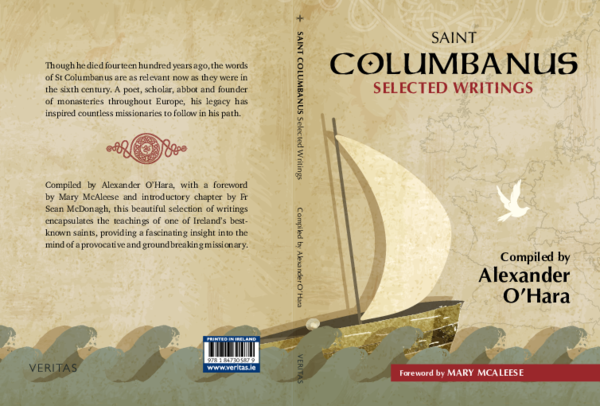St Columbanus: Selected writings
compiled by Alexander O’Hara, introduction by Fr Sean McDonagh (Veritas, €9.99 / £7.25)
Columbanus and the Peoples of Post-Roman Europe
edited by Alexander O’Hara (Oxford University Press, £68.00)
Jonas of Bobbio and the Legacy of Columbanus: Sanctity and Community in the Seventh Century
by Alexander O’Hara (Oxford University Press, £55.00)
St Columbanus (born 540 – died 615) has long been one of the culture heroes of Ireland. But over time our understanding of his character, life and achievements and place in European history has evolved. He has often been pointed out as the first person in the post-imperial times to speak of the totality of Europe, seeing it as a Christian entity.
For Irish people he has been seen as one of those who ‘saved Europe for civilisation’ – in the words of a recent best seller. But the picture as it now emerges is more complex, more varied and nuanced than many have thought in trying to simplify the saint to fit an Irish narrative of national identity. Rather, the emphasis is the development of European identities in the centuries after the collapse of the Roman Empire.
Alexander O’Hara is one of those associated with this drive towards new insights and a deeper understanding. National sentiment plays a lesser role in his work. Honorary Research Fellow of the School of history in the University of St Andrews, he is currently a Research Fellow of the Institut für Mittelalter forschung in Vienna. These three books are representative of his output as a scholar.
The selection from the saint’s writings is intended to give a brief survey which will be immediately accessible to the general reader and proves an essential basic grounding in his outlook.
Such conference papers as these give readers an early taste of new thinking”
The two books from OUP are, however, intended for a more specialist, largely academic readership. But nevertheless they both contain essays and discussions which will interest a wide range of readers (even if they prefer to borrow them from a library rather than buy them!).
The essays on Columbanus and the peoples of post-Roman Europe were developed from the papers presented at a conference in Vienna in 2013. Their focus is on presenting Columbanus in the context of his times as they are now understood.
Having set the general picture, three sections deal in turn with Columbanus as a product of insular Christianity, before moving to deal in some detail with his work in the Frankish kingdoms of western Europe and then with Almannia on the borders of Switzerland and Austria, the region around the eastern end of Lake Constance and Bregenz.
The last section deals with Columbanus’s final years in Italy, especially at Bobbio, and its effect on how the legacy of Columbanus is seen.
Divergent roles
All this provides a great deal to take in. Two of these areas, Brittany and the region around Bregenz, are familiar to me (in the latter case from their divergent roles in the lives of Conan Doyle and James Joyce, believe it or not).
In the context of my own interests I was struck by a foot note in Ian Wood’s essay about Columbanus in Brittany. Most scholars have assumed that he landed there near the mouth of the Rance. But this, I think is because few scholars have much experience of maritime matters.
Wood points out that Jonas of Bobbio says the saint landed in the sinus Brittanicus. Woods surmises this means the Golfe de Morbihan. He is surely correct, for this region has been densely populated and a centre of high culture since neolithic times. Here were Venetti, those stalwart mariners, who gave Julius Caesar so much trouble.
He admits that this identification we made as far back as 1915 “although it has fallen from academic consciousness” – a lovely phrase.
The footnote directs to a work by Helena Concannon published by the Irish Catholic Truth Society in 1915. This was no mere pamphlet, but a substantial work of over 300 pages – a thing difficult to lose sight of, one would have thought. But clearly she was a popular author, one not be regarded as “part of the literature” of the subject. How very revealing of the academic cast of mind.
O’Hara’s biographical study of the saint’s biographer investigates the immediate heritage of the saint and the development of his early image and cultus. This, too, is written in the context, not of Ireland, but of the emerging Europe.
Such conference papers as these give readers an early taste of new thinking. In five years they will be the basis of books, in ten years the foundation of received opinion (which constantly changes). Reading them now gives readers an exciting glimpse of scholarship in the making.
(For further background see the long interview with Alexander O’Hara about his research and views on St Columbanus in the issue of The Irish Catholic for November 15, 2018.)


 Peter Costello
Peter Costello St Columbanus:
Selected writings
Photo: Academia
St Columbanus:
Selected writings
Photo: Academia 